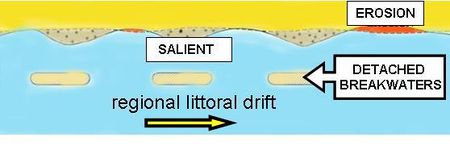Detached shore parallel breakwaters
This article describes a specific type of coastal defence. Detached shore parallel breakwaters are an example of an "artificial reef". For a more extensive treatment see Detached breakwaters.
Contents
Background of erosion management
Beach erosion and the corresponding shoreline retreat cause unacceptable economic and environmental risks in numerous coastal areas. Shoreline erosion control structures as groynes and detached breakwaters, beach nourishment or a combination of structures and sediment addition are the most common responses to the risk caused by persistent beach erosion. The selection of the appropriate technique for shoreline erosion control requires taking into consideration the physical and economic conditions (e.g. wave climate or quarries), the social environment (e.g. aesthetic rules or tourism) as well as the environmental impact of construction and service (e.g. material footprint, reversibility or pollution) (see also ICZM). Sustainable shoreline erosion control measures demand an adequate assessment of economic, social and environmental aspects not only for the construction of the coastal structures, but also for the maintenance and lifetime service as well as the rebuilding or dismantling of structures when their lifetime is over.
Detached breakwaters
Detached breakwaters usually refer to a category of shoreline erosion control structures most frequently placed parallel to the coast to reduce the energy attacking the coastline. The term “Low crested Structures” (LCSs) usually designates the most common detached breakwater types, which are made of quarry materials having a low crest which allows significant energy transmission. The higher the crest freeboard, the higher the aesthetic impact and the lower the wave transmission to the shoreline is. The LCSs for shoreline erosion control are generally constructed with negative crest freeboard (submerged detached breakwaters) or with small positive crest freeboard to minimize the aesthetic impact. Submerged LCSs can also be functionally used as an artificial reef to support a perched beach. Detached breakwaters can be classified as single or segmented, emerged or submerged, narrow or broad crested, etcetera (see also the article detached breakwaters). Figure 1 shows a typical segmented detached breakwater scheme for shoreline erosion control.
Application of detached breakwaters
Crest freeboard, distance to the shoreline, breakwater length and gap width are the principal factors affecting the hydrodynamic field and the corresponding beach response to a series of segmented detached breakwaters. The higher the breakwater length and crest freeboard and the lower the gap width and distance to shoreline, the lower the energy transmission and the higher the induced sinuosity of the beach and reduction of sand longshore transport will be. If the induced beach sinuosity reaches the detached breakwater, a tombolo is formed and the functional behaviour is similar to a T-groyne. Detached breakwaters reduce the longshore transport of sand and may cause or significantly increase erosion in nearby unprotected beaches; therefore, sustainable erosion control schemes may be analysed from a global point of view in which single or segmented detached breakwater may be the best solution in a specific coastal area.
To reduce the economic and environmental impact of traditional LCSs, a variety of prefabricated concrete structures have been proposed to construct detached breakwaters. The prefabrication of concrete elements reduces the environmental impact on the beach, changing the conventional quarry dumping construction by installation of prefabricated concrete elements with a specific design. The material footprint is smaller and the dismantling of the prefabricated concrete structures is also easier than that of conventional LCSs. Contrary to the described environmental advantages, the prefabricated concrete detached breakwaters are difficult to repair; they are sensitive to scour processes and have a relative low number of experiences around the world with different proprietary designs. Prefabricated concrete detached breakwaters are also named “artificial reefs” given their similitude with natural reefs protecting beaches or natural reefs supporting perched beaches. However, it is necessary to note that the “artificial reef” is a more general concept which may be associated to submerged man-made structures of any artificial material (e.g. concrete, steel or fibreglass) which may be similar to natural reefs.
See also the articles: Applicability of detached breakwaters, Artificial reefs.
Effects of artificial reefs
Like natural reefs, artificial reefs may respond to a variety of goals. The oldest and most common application of artificial reefs is in fishery enhancement whereby they increase the biological productivity of a zone or improve the ecological stability. During the last few decades, a variety of artificial reefs designed for different purposes have been spread around the world, including artificial surfing reefs, artificial reefs for shoreline erosion control, for protecting coral reefs and other ecosystems, for preventing trawling, and so forth. Sustainability requires reducing the ecological footprint and artificial reefs are structures which may contribute to diminishing the global ecological footprint serving different purposes, one of them being shoreline beach erosion control.
See also
Other articles about detached breakwaters are:
Other articles about breakwaters in general:
Articles about coastal protection measures:
Articles about th design of detached breakwaters
References
Please note that others may also have edited the contents of this article.
|
